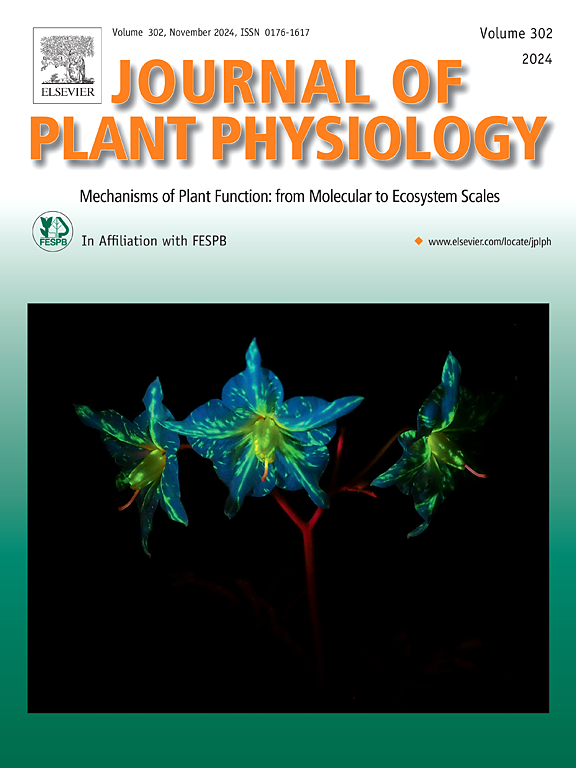A mycoheterotrophic orchid uses very limited soil inorganic nitrogen in its natural habitat
IF 4
3区 生物学
Q1 PLANT SCIENCES
引用次数: 0
Abstract
Mycoheterotrophic plants acquire nitrogen (N) directly from the soil and through their symbiotic fungi. The fungi-derived N has received considerable attention, but the contribution of soil-derived N has been largely overlooked. We investigated how the leafless, rootless, and almost mycoheterotrophic orchid Cymbidium macrorhizon obtains soil N by applying 15N-labeled ammonium nitrate in its natural habitat, and tracking metabolite accumulation and mycorrhizal fungal association after N application. The decline of N in the rhizome from flowering to fruiting indicated a transfer of N from the rhizome to fruits. At current dose of N application (0.6 g NH4NO3 each plant), only 1.5% of the plant's N was derived from fertilizer, resulting in a low nitrogen use efficiency of 0.27%. The majority of those newly absorbed N (88.89%) was found sank in the rhizome. Amino acids (or their derivatives) and alkaloids were predominant differentially accumulated nitrogenous metabolites after N application, with amino acids occurring in both fruits and the rhizome, and alkaloids primarily in the fruits. The addition of N did not alter the richness of mycorrhizal fungi, but did affect their relative abundance. Our findings suggest that Cymbidium macrorhizon uses very limited soil inorganic nitrogen in its natural habitat, and the root-like rhizome primarily stores N rather than absorbs its inorganic forms, offering new insights into how mycoheterotrophic plants utilize soil N, and the influence of nutrient availability on the orchid-fungi association.
在自然栖息地,绵状异养型兰花对土壤中无机氮的利用非常有限。
菌根营养型植物直接从土壤中获取氮(N),并通过共生真菌获取氮。由真菌获得的氮已受到广泛关注,但由土壤获得的氮在很大程度上被忽视了。我们研究了无叶、无根、几乎是菌根营养型兰花大花蕙兰如何通过在其自然栖息地施用 15N 标记的硝酸铵来获得土壤中的氮,并跟踪施氮后代谢物的积累和菌根真菌的关联。从开花到结果,根状茎中的氮含量下降,表明氮从根状茎转移到了果实中。在当前的施氮剂量下(每株 0.6 克 NH4NO3),只有 1.5% 的植物氮来自肥料,导致氮利用率低至 0.27%。新吸收的氮大部分(88.89%)沉积在根茎中。氨基酸(或其衍生物)和生物碱是施氮后主要的差异累积氮代谢产物,氨基酸出现在果实和根茎中,生物碱主要出现在果实中。添加氮不会改变菌根真菌的丰富度,但会影响其相对丰度。我们的研究结果表明,大花蕙兰在其自然栖息地中对土壤中无机氮的利用非常有限,根状茎主要是储存氮而不是吸收无机氮,这为我们了解菌根真菌植物如何利用土壤中的氮以及养分供应对兰花与真菌关系的影响提供了新的视角。
本文章由计算机程序翻译,如有差异,请以英文原文为准。
求助全文
约1分钟内获得全文
求助全文
来源期刊

Journal of plant physiology
生物-植物科学
CiteScore
7.20
自引率
4.70%
发文量
196
审稿时长
32 days
期刊介绍:
The Journal of Plant Physiology is a broad-spectrum journal that welcomes high-quality submissions in all major areas of plant physiology, including plant biochemistry, functional biotechnology, computational and synthetic plant biology, growth and development, photosynthesis and respiration, transport and translocation, plant-microbe interactions, biotic and abiotic stress. Studies are welcome at all levels of integration ranging from molecules and cells to organisms and their environments and are expected to use state-of-the-art methodologies. Pure gene expression studies are not within the focus of our journal. To be considered for publication, papers must significantly contribute to the mechanistic understanding of physiological processes, and not be merely descriptive, or confirmatory of previous results. We encourage the submission of papers that explore the physiology of non-model as well as accepted model species and those that bridge basic and applied research. For instance, studies on agricultural plants that show new physiological mechanisms to improve agricultural efficiency are welcome. Studies performed under uncontrolled situations (e.g. field conditions) not providing mechanistic insight will not be considered for publication.
The Journal of Plant Physiology publishes several types of articles: Original Research Articles, Reviews, Perspectives Articles, and Short Communications. Reviews and Perspectives will be solicited by the Editors; unsolicited reviews are also welcome but only from authors with a strong track record in the field of the review. Original research papers comprise the majority of published contributions.
 求助内容:
求助内容: 应助结果提醒方式:
应助结果提醒方式:


